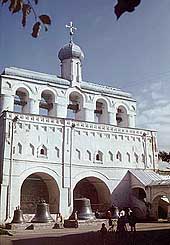The world truly is getting smaller. Finding a romantic
place to journey which is really going to have your friends and family on the
edge of their chairs during the telling, is getting more difficult every year.
Our jaded neighbours and relatives have seen it all. Or have they? The
traveller should be prepared to view monasteries and churches, but also be
historically receptive.
 Church
of St. John the Baptist
Church
of St. John the Baptist
Close enough to St. Petersburg to make the side trip
worthwhile, Novgorod lies right in the middle of what is sometimes called
White Russia. Often referred to as the cradle of Russian culture, it is the
gateway to the East. Novgorod is one of Russia’s oldest cities, and
developed into an important centre in the 11th century, embracing both sides
of the River Volkhov, with the Cathedral of Sophia on the left bank and the
trading quarter on the right. The Volkhov is discharged from Lake Llmen, four
miles away, and this region has some recent historical significance, as do the
Valdai  Heights. Here battles were fought in the Second World War. The soldiers
who survived the first Russian winter were given a medal; nicknamed the
‘frozen meat” medal. It came with a ribbon; a thin black stripe in the
middle, then a bit of white to the right and left. The German infantry
invented a jingle about it which roughly translates: “Black is the runway,
white are the snows, and right and left the Red Army grows”.
Heights. Here battles were fought in the Second World War. The soldiers
who survived the first Russian winter were given a medal; nicknamed the
‘frozen meat” medal. It came with a ribbon; a thin black stripe in the
middle, then a bit of white to the right and left. The German infantry
invented a jingle about it which roughly translates: “Black is the runway,
white are the snows, and right and left the Red Army grows”.
St.
Sophia’s belfry
Today, Novgorod is a medium sized industrial town. It was
at one time the main commercial port for lynx and sable furs, beeswax, timber,
grain, hunting falcons, and walrus ivory. Now machines, electronic equipment,
furniture and glassware are manufactured here.
The church of St Sophia is topped with five domes, and the
west portal is famous for its Novgorod bronze door, which was made in
Magdeburg, Germany in the middle of the 12th century. It consists of a number
of bronze panels divided into twenty six sections with scenes of the Old
Testament and the life of Christ in bold relief.